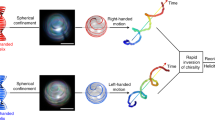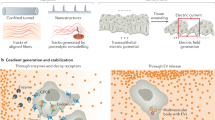Abstract
Organisms that move along helical trajectories change their net direction of motion largely by changing the direction, with respect to the body of the organism, of their rotational velocity (Crenshaw and Edelstein-Keshet, 1993,Bull. math. Biol. 55, 213–230). This paper demonstrates that an organism orients to a stimulus field, such as a chemical concentration gradient or a ray of light, if the components of its rotational velocity, with respect to the, body of the organism, are simple functions of the stimulus intensity encountered by the organism. For example, an organism can orient to a chemical concentration gradient if the rate at which it rotates around its anterior-posterior axis is proportional to the chemical concentration it encounters. Such an orientation can be either positive or negative. Furthermore, it is true taxis—orientation of the axis of helical motion is direct. It is neither a kinesis nor a phobic response—there is no random component to this mechanism of orientation.
Similar content being viewed by others
Literature
Berg, H. C. 1975. Chemotaxis in bacteria.A. Rev. Biophys. Bioengn 4 119–136.
Boscov, J. S. and M. E. Feinleib. 1979. Phototactic response ofChlamydomonas to flashes of light. II. Response of individual cells.Photochem. Photobiol. 30, 499–505.
Brokaw, C. J. 1958a. Chemotaxis of bracken spermatozoids. Ph.D. thesis Cambridge, University, Cambridge, U.K.
Brokaw, C. J. 1958b. Chemotaxis of bracken spermatozoids: Implication of electrochemical orientation.J. exp. Biol. 35, 197–212.
Brokaw, C. J. 1959. Random and oriented movements of bracken spermatozoidsJ. cell. comp. Physiol. 54, 95–101.
Brokaw, C. J. 1974. Calcium and flagellar response during the chemotaxis of bracken spermatozids.J. cell. Physiol. 83, 151–158.
Brokaw, C. J. 1979. Calcium-induced asymmetrical beating of Triton-demembranated sea urchin sperm flagella.J. Cell Biol. 82, 401–411.
Brokaw, C. J., R. Josslin and L. Bobrow. 1974. Calcium ion regulation of flagellar beat symmetry in reactivated sea urchin spermatozoa.Biochem. Biophys. Res. Commun. 58, 795–800.
Bullington, W. E. 1925. A study of spiral movement in the ciliate infusoria.Arch. Protistenk. 50, 219–275.
Crenshaw, H. C. 1989. Kinematics of helical motion of microorganisms capable of motion with four degrees of freedom.Biophys. J. 56, 1029–1035. (Note correction inBiophys. J. 57, 1109.)
Crenshaw, H. C. 1990. Helical orientation: A novel mechanism for the orientation of microorganisms.Lect. Notes Biomath.89, 361–386.
Crenshaw, H. C. 1993. Orientation by helical motion—I. Kinematics of the helical motion of organisms with up to six degrees of freedom.Bull. math. Biol. 55, 197–212.
Crenshaw, H. C. and L. Edelstein-Keshet. 1993. Orientation by helical motion—II. Changing the direction of the axis of motion.Bull. math. Biol. 55, 231–255.
Diehn, B. 1973. Phototaxis and sensory transduction inEuglena. Science 181, 1009–1015.
Diehn, B., M. Feinleib, W. Haupt, E. Hildebrand, F. Lenci and W. Nultsch. 1977. Terminology of behavioral responses of motile microorganisms.Photochem. Photobiol. 26, 559–560.
Fenchel, T. 1987.Ecology of Protozoa: The Biology of Free-living Phagotrophic Protists, p. 197. Madision, WI: Science Tech Publishers.
Foster, K. W. and R. D. Smyth. 1980. Light antennas in phototactic algae.Microbiol. Rev. 44, 572–630.
Foster, K. W., J. Saranak, N. Patel, G. Zarilli, M. Okabe, T. Kline and K. Nakanishi. 1984. A rhodopsin is the functional photoreceptor for phototaxis in the unicellular eukaryoteChlamydomonas.Nature 311, 756–759.
Fraenkel, G. S. and D. L. Gunn. 1940.The Orientation of Animals: Kineses, Taxes, and Compass Reactions 325 pp. Oxford, U.K.: Oxford University Press.
Gibbons, B. H. and I. R. Gibbons. 1980. Calcium-induced quiescence in reactivated sea urchin sperm.J. Cell Biol. 84, 13–27.
Goldstein, S. F. 1977. Asymmetric waveforms in echinoderm sperm flagella.J. exp. Biol. 71, 157–170.
Harz, H. and P. Hegemann. 1991. Rhodopsin-regulated calcium currents inChlamydomonas.Nature 351, 489–491.
van Houten, J. and R. R. Preston. 1988. Chemokinesis. InParamecium, H. D. Görtz (Ed.), pp. 282–300. New York, NY: Springer-Verlag.
Jennings, H. S. 1904.Contributions to the Study of the Behavior of Lower Organisms. Carnegie Institute of Washington, Publication No. 16.
Kamiya, R. and G. B. Witman. 1984. Submicromolar levels of calcium control the balance of beating between the two flagella in demembranated models ofChlamydomonas.J. Cell Biol. 98, 97–107.
Kreimer, G. and M. Melkonian. 1990. Reflection confocal laser scanning microscopy of eyespots in flagellated green algae.Eur. J. Cell Biol. 53, 101–111.
Ludwig, W. 1929. Untersuchungen über die schraubenbahnen niederer organismen.Z. vergl. Physiol. 9, 734–801.
Machemer, H. 1988a. Electrophysiology. InParamecium, H. D. Görtz (Ed.), pp. 185–215, New York, NY: Springer-Verlag.
Machemer, H. 1988b. Motor control of cilia. InParamecium, H. D. Görtz (Ed.), pp. 216–235. New York, NY: Springer-Verlag.
Machemer, H. 1989. Cellular behaviour modulated by ions: Electrophysiological implications.J. Protozool. 36, 463–487.
Miller, R. L. 1985. Sperm chemo-orientation in the metazoa. InBiology of Fertilization, Vol. 2.Biology of the Sperm, C. B. Metz and A. Monroy (Ed), pp. 276–337. New York, NY: Academic Press.
Miller, R. L. and C. J. Brokaw. 1970. Chemotactic turning behaviour ofTubularia spermatozoa.J. exp. Biol. 52, 699–706.
Okuno, M. and C. J. Brokaw. 1981. Effects of Triton-extraction conditions on beat symmetry of sea urchin sperm flagella.Cell Motil. 1, 363–370.
Omoto, C. K. and C. J. Brokaw. 1985. Bending patterns of Chlamydomonas flagella. II. Calcium effects on reactivated Chlamydomonas flagella.Cell Motil. 5, 53–60.
Párducz, B. 1964. Swimming and its ciliary mechanism inOphryoglena sp.Acta Protozool. 2, 367–374.
Rüffer, U. and W. Nultsch. 1987. Comparison of the beating of cis- and trans-flagella ofChlamydomonas cells held on micropipettes.Cell Motil. Cytoskel. 7, 87–93.
Rüffer, U. and W. Nultsch. 1990. Flagellar photoresponses ofChlamydomonas cells held on micropipettes: I. Change in flagellar beat frequency.Cell Motil. Cytoskel. 15, 162–167.
Rüffer, U. and W. Nultsch. 1991. Flagellar photoresponses ofChlamydomonas cells held on micropipettes: II. Change in flagellar beat pattern.Cell Motil. Cytoskel. 18, 269–278.
Author information
Authors and Affiliations
Rights and permissions
About this article
Cite this article
Crenshaw, H.C. Orientation by helical motion—III. Microorganisms can orient to stimuli by changing the direction of their rotational velocity. Bltn Mathcal Biology 55, 231–255 (1993). https://doi.org/10.1007/BF02460304
Received:
Revised:
Issue Date:
DOI: https://doi.org/10.1007/BF02460304




